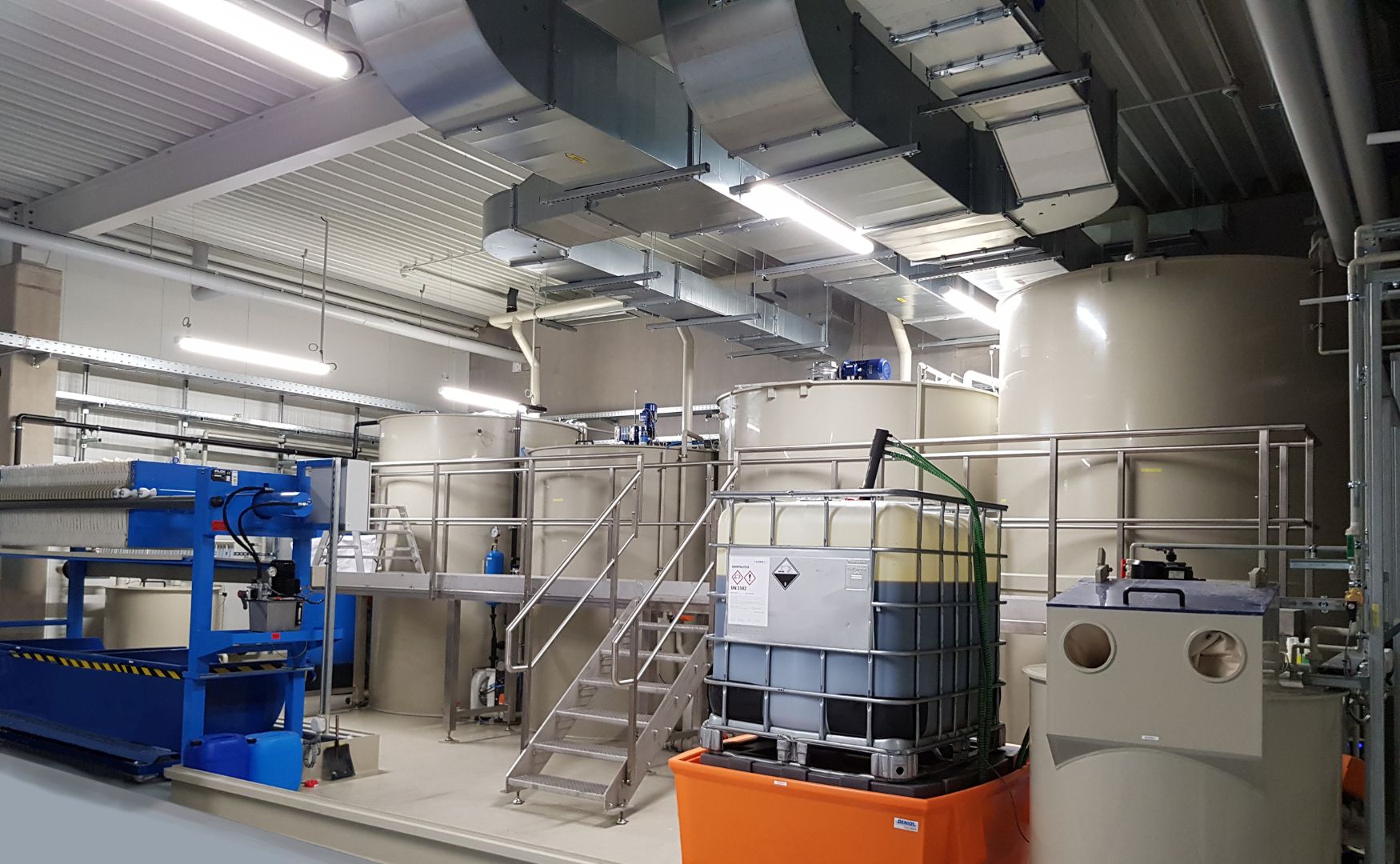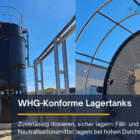Neutralization precipitation is a central process in industrial wastewater treatment in which dissolved compounds are converted into insoluble solids by pH regulation. This technique is often used to remove heavy metals, phosphates and other pollutants from wastewater. Neutralization precipitation ensures that metals and other dissolved substances are effectively removed by adjusting the pH value of the wastewater so that these substances precipitate as hydroxides, carbonates or other poorly soluble compounds.
Table of contents
Technical background
pH control:
- Neutralization precipitation is based on adjusting the pH value of the wastewater to promote the formation of insoluble compounds. In many cases, the pH value is adjusted by adding acids (e.g. sulphuric acid) or bases (e.g. sodium hydroxide) so that heavy metals are precipitated as metal hydroxides.
- A pH value between 8 and 9 is optimal for the precipitation of metals such as iron, zinc, copper or nickel, as the hydroxides of these metals are least soluble in this range.
Reaction chemistry:
- During the precipitation of metals, metal hydroxides are formed by the addition of alkalis, which combine to form fine particles. This reaction depends on the concentration of the metal ions and the reaction time.
- Calcium hydroxide (milk of lime) is often used for the precipitation of phosphates, which binds the phosphates as calcium phosphate and converts them into insoluble solids. This technique is particularly common in the food and beverage industry, where phosphate-containing wastewater has to be treated.

Photo: Our ALMA CHEM MCW wastewater treatment plant for the precipitation and flocculation of heavy metals, AOX, hydrocarbons and cyanides
Areas of application
Metalworking industry:
- In electroplating and surface treatment, the waste water contains high concentrations of heavy metals such as chromium, nickel and copper, which are removed from the water as hydroxides by neutralization precipitation. The precise adjustment of the pH value ensures that the metals are converted into insoluble forms and can then be removed by sedimentation, filtration or flotation.
Food and beverage industry:
- In this industry, phosphate-containing wastewater is produced, which is treated by neutralization precipitation with calcium hydroxide. The pH value is adjusted so that calcium phosphate precipitates and is separated as sludge. This is crucial to prevent over-fertilization of water bodies with phosphates and to ensure compliance with limit values.
Chemical and pharmaceutical industry:
- Wastewater in these industries can have highly acidic or alkaline properties. Neutralization precipitation is used here to bring the pH value of the wastewater to a neutral range in which impurities such as metals and phosphates are best precipitated. Special neutralization agents are often used, which are specifically selected for the composition of the wastewater.
Paper and pulp industry:
- In this industry, neutralization precipitation is used to remove organic and inorganic residues, in particular phosphates and lime deposits, from wastewater. This is important to prevent deposits and corrosion in the systems and to increase the efficiency of the subsequent treatment steps.
Paint and coatings industry:
- Neutralization precipitation is used here to precipitate pigments and metal ions that are often found in wastewater from this industry. Through precise pH adjustment, these substances are bound as insoluble compounds and then removed from the wastewater by filtration or sedimentation.
Process engineering implementation
In neutralization precipitation plants, the wastewater is mixed in reaction tanks with agitators or reaction loops to ensure an even distribution of the precipitants and an optimal reaction time. The dosing of acids or alkalis is usually automated and is continuously monitored to ensure that the pH value remains within the desired range.
Depending on the composition of the wastewater and the type of compounds to be treated, precipitation can be supplemented by other processes such as flocculation in order to aggregate the fine particles into larger flocs and thus facilitate separation.
Chromate reduction using sodium bisulfite
A special application of neutralization precipitation is chromate reduction. Chromium(VI), which is highly toxic and strongly oxidizing, is reduced to chromium(III) with sodium bisulphite (NaHSO₃). The resulting chromium(III) is then precipitated as a hydroxide by adjusting the pH with lye. This technique is used particularly in surface technology to convert toxic and mobile chromium(VI) compounds into less hazardous forms and to separate them safely.
Advantages and challenges
Advantages:
- Neutralization precipitation is a cost-effective and proven method for removing dissolved pollutants and regulating the pH value.
- It can be flexibly adapted to different types of wastewater and can be easily integrated into many branches of industry.
- The method is particularly suitable for removing a wide range of substances such as metals and phosphates from wastewater.
Challenges:
- Precise pH control is required to ensure that precipitation is efficient and all pollutants are converted into insoluble forms.
- The subsequent separation of the solids formed often requires additional steps such as flocculation or filtrationto ensure a high separation efficiency.
Conclusion
Neutralization precipitation is an extremely versatile and effective process for treating industrial wastewater. By adjusting the pH and adding specific chemicals, metals, phosphates and other pollutants can be efficiently removed. In combination with complementary technologies such as flocculation and filtration neutralization precipitation offers a reliable way of treating wastewater so that it meets legal requirements and ensures high water quality.
For further information on our products, please feel free to contact us at any time!

Photo: Our ALMA CHEM MCW wastewater treatment plant for the precipitation and flocculation of heavy metals, AOX, hydrocarbons and cyanides








